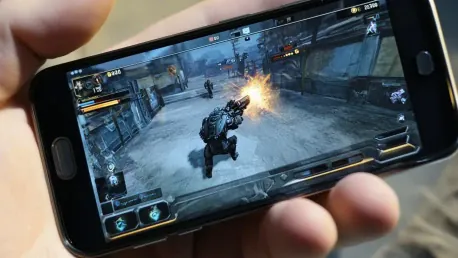The mobile gaming industry is on the brink of a transformative era, with predictions for 2025 indicating significant advancements and shifts across various facets. From direct-to-consumer web experiences to the integration of AI and the evolution of advertising methodologies, the landscape is set to change dramatically. Industry experts have provided insights into these upcoming trends, painting a picture of a future where gaming and digital marketing are more personalized, interactive, and integrated into daily life. This shift is poised to redefine how developers, marketers, and players interact within the digital ecosystem, creating opportunities for innovation and growth.
Direct-to-Consumer Web Experiences
The evolution of direct-to-consumer (D2C) web experiences is expected to continue beyond traditional webshops. This trend is anticipated to penetrate mainstream players and more casual gaming genres as developers and white-label providers become proficient in creating sophisticated, fully-featured consumer web experiences. Facilitating direct engagement with players not only enhances margins but also enables more personalized marketing and merchandising, resulting in a richer player experience. Game developers are becoming more skilled at e-commerce merchandising and diversifying their marketing tactics beyond user acquisition (UA).
D2C approaches are becoming more feasible for casual gaming due to improved customer-friendly interfaces and comprehensive content and services. The ability to directly engage with players allows developers to offer more personalized experiences, driving higher engagement and loyalty. By embracing these advancements, developers can create immersive environments that cater to individual preferences, enhancing the overall gaming experience. The shift towards D2C models signals a move away from traditional reliance on third-party platforms, empowering developers to establish a more direct connection with their audience. This, in turn, fosters greater creativity and innovation within the industry.
Integration of Gaming and Lifestyle Platforms
The distinction between games and lifestyle platforms is becoming increasingly blurred. Mobile gaming is incorporating more social features, real-world integrations, and co-creation opportunities. These integrations will make mobile gaming a more formal part of daily life, fostering connections, creativity, and relaxation through interactive and personalized gaming experiences. As gaming becomes more intertwined with lifestyle elements, players will find new ways to connect and engage with each other. This trend will lead to the creation of more immersive and engaging experiences that extend beyond traditional gameplay.
The fusion of gaming and lifestyle platforms will also open up new opportunities for brands to connect with consumers in meaningful ways. By leveraging the growing trend of social gaming, brands can create interactive and personalized campaigns that resonate with their target audience. This integration will not only drive player engagement but also create a more holistic and enriched user experience. As gaming continues to embed itself into daily routines, it will likely serve as a catalyst for further innovation, encouraging developers and marketers to explore new, creative ways to integrate their offerings seamlessly into the lives of their users.
Emergence of Interactive Out-of-Home Advertising
Interactive Out-of-Home (IOOH) advertising is set to revolutionize the advertising space. Self-driving cars are becoming entertainment hubs, offering new ways for advertisers to engage passengers. Interactive ads on rideshare platforms are already showing significantly higher engagement rates than traditional video ads, indicating their immense potential. IOOH will expand into various public spaces like retail stores, gas stations, kiosks, and airline headrests, facilitated by touch-enabled, dynamic screens. With airlines investing in technologies such as in-flight internet, programmatic ads will become prevalent during air travel, mirroring the success of ad-based models seen in companies like Uber.
This shift towards interactive advertising will create more engaging and personalized experiences for consumers. By leveraging the power of interactive technology, advertisers can create more immersive and impactful campaigns that resonate with their target audience. As the advertising landscape evolves, brands will need to adapt their strategies to effectively engage with consumers in these new, dynamic environments. The rise of IOOH advertising signifies a move towards a more connected and interactive world, where brands can engage with consumers in real-time, creating memorable and impactful experiences. This, in turn, will drive greater brand loyalty and engagement, fostering a more dynamic and interactive advertising ecosystem.
AI-Driven Real-Time Gaming Experiences
AI is set to elevate gaming experiences by enabling real-time, player-driven interactions. Games will feature dynamic content, adaptive levels, and evolving storylines based on player behavior. AI integration in game design and A/B testing will enhance the gaming experience, as seen with games like Block Blast! that utilize AI technologies for these purposes. The use of AI in gaming will allow developers to create more personalized and engaging experiences for players. By analyzing player behavior and preferences, AI can help developers tailor content and gameplay to individual players, driving higher engagement and satisfaction.
This trend will also enable smaller studios to compete with larger developers by streamlining workflows and enhancing player experiences. AI-driven tools will empower developers to create more sophisticated and dynamic gaming environments, fostering innovation and growth within the industry. The integration of AI in gaming signifies a shift towards more immersive and personalized experiences, where players can expect content to evolve and adapt based on their actions and preferences. This not only enhances the overall gaming experience but also encourages longer play sessions and deeper engagement, driving a more loyal and dedicated player base.
Fusion of Branding, KOL, and Performance Marketing
The integration of branding marketing, Key Opinion Leader (KOL) marketing, and performance marketing is gaining traction. This holistic approach to marketing strategies will allow brands to connect with consumers in more meaningful ways. By leveraging the influence of KOLs and combining it with performance marketing tactics, brands can create more effective and engaging campaigns. This trend will also drive the development of new marketing strategies that focus on building long-term relationships with consumers.
By integrating branding, KOL, and performance marketing, brands can create more personalized and engaging experiences for their audiences, driving higher engagement and loyalty. The fusion of these marketing approaches signifies a move towards a more comprehensive and integrated strategy, where brands can leverage multiple touchpoints to engage with their target audience. By creating a seamless and cohesive experience across different marketing channels, brands can drive greater awareness, engagement, and loyalty. The rise of this integrated approach highlights the importance of connecting with consumers in meaningful and authentic ways, fostering deeper relationships and driving long-term success.
Analytics and Optimization with OpenTelemetry
Development teams are shifting from a reactive “Find & Fix” mentality to a proactive “Measure and Optimize” approach using OpenTelemetry. This shift will allow for deeper analysis and connectivity between business KPIs and user impact. Cohorted KPIs will become crucial for staying competitive, driving development teams to use a common data set for prioritizing impactful issues. By adopting a proactive approach to analytics and optimization, developers can identify and address issues before they impact the user experience. This will lead to more stable and reliable gaming experiences, driving higher engagement and satisfaction among players.
The use of OpenTelemetry will also enable developers to gain deeper insights into player behavior and preferences, allowing for more personalized and engaging experiences. By leveraging the power of data, developers can create more dynamic and responsive gaming environments, enhancing the overall player experience. The shift towards a proactive approach to analytics and optimization signifies a move towards a more data-driven industry, where developers can leverage actionable insights to drive growth and innovation. This, in turn, will foster a more competitive and dynamic gaming landscape, where developers can continually refine and enhance their offerings to meet the evolving needs of their players.
Further AI Advancements and Distribution Changes
The mobile gaming industry is on the verge of a significant transformation, with forecasts for 2025 predicting major advancements and changes in various aspects. From the rise of direct-to-consumer web experiences to the incorporation of artificial intelligence, and evolving advertising methods, the landscape promises to shift profoundly. Experts provide a glimpse into these forthcoming trends, highlighting a future where gaming and digital marketing become more tailored, engaging, and seamlessly woven into everyday life. This evolution is set to revolutionize interactions among developers, marketers, and players within the digital ecosystem, paving the way for new opportunities for innovation and growth. As technology advances, the line between gaming and other digital experiences will blur, offering more immersive and integrated experiences. This will not only enhance user engagement but also open up fresh avenues for personalized marketing strategies, making the mobile gaming industry a hotbed for technological and creative advancements in the near future.









